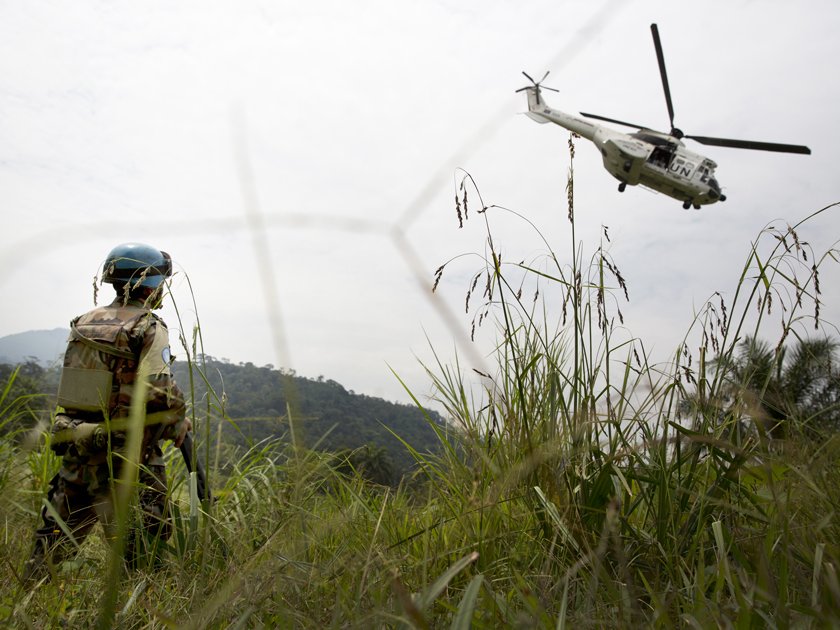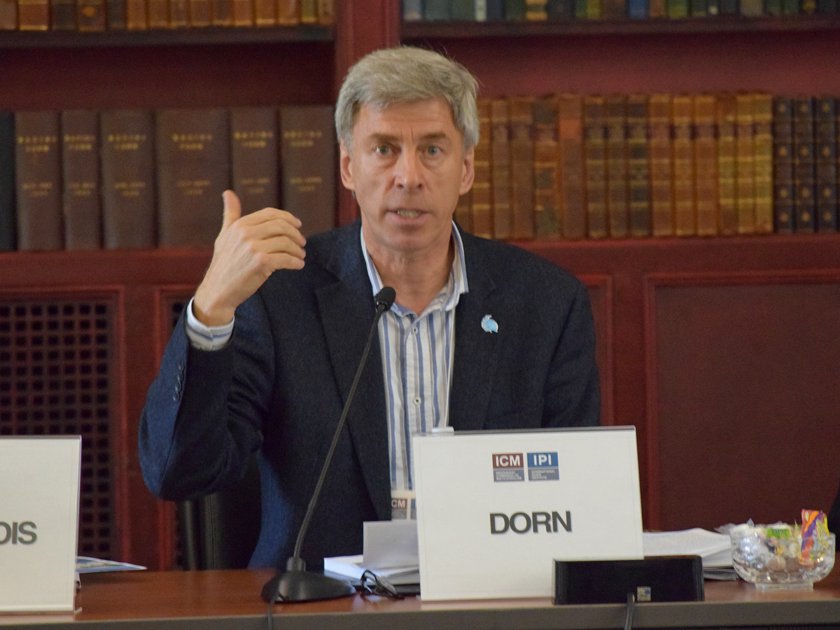While there’s been progress to bring technology into United Nations peacekeeping, in general the UN has been off the pace in this regard, according to Walter Dorn, Professor of Defense Studies at the Royal Military College of Canada.
Countries would bring new technologies to UN missions but would leave with them when they left, he said, describing the history of adoption as “sporadic.”
Mr. Dorn spoke to International Peace Institute Senior Adviser Warren Hoge on the sidelines of ICM’s seventh retreat, on the impact of new technology on peace, security, and development, held on October 23-24.
What is the history of the use of technology in UN peace operations?
It’s a very sporadic history. In the history of peacekeeping, various contingents and countries brought in technologies. When they left that mission, they would take the technology with them. So you had the Western countries sometimes bringing in superb technology and then leaving with it and the developing world bringing less technology.
There were lots of cases in UN history where countries brought in the technology. The Congo operation in the 1960s saw aerial reconnaissance jets provided by Sweden. There were radars provided by Norway to be able to look at aircraft in the area, to be able to see where the fighter jets from Katanga were flying. The Swedes brought night-vision devices early on into Cyprus. The Irish brought in various robots to be able to look at detection of IEDs (improvised explosive devices), landmines, or explosive devices that they wanted to be able to control and actually disarm. So we have these bright spots, but in general the UN has been technophobic.
It saw peacekeeping as being a human-centered activity—which it should be—and erroneously concluded that there wasn’t a role for technology. Technology didn’t play a role because it was on the basis of quite a simple view of the engagement with conflicting parties. But the increased awareness in human society of the role of technology, the increased use of cell phones and smartphones, means that there’s a higher awareness in the UN secretariat.
There are a lot of Western countries—particularly now, post-Afghanistan—that would like to deploy back in peacekeeping, and they’re so used to deploying with advanced kit that the UN has to become partly up to speed with those countries.
I think that there’s now solid progress as of the last year or two, with the UN having its first mission asset unmanned aerial vehicles (UAVs) being deployed in the Congo, and lots of projects are underway that there’s a systematic effort to bring technology into peacekeeping now.
We read about the drones that peacekeepers are using in some places. How much of what is out there right now does the UN have access to?
In terms of the range of technologies, it’s a small fraction. For instance, if we’re looking at monitoring and surveillance technologies, the UN has not yet deployed aerostats—that’s tethered balloons with cameras on them. It hasn’t deployed acoustic sensors, where you can detect the type of vehicles that are going by. It hasn’t used seismic sensors, which detect the vibrations on the ground—you can see people walking or vehicles moving nearby. There’s infrared break-beams and taut wire fences—these are all technologies that could be used to improve the security of the peacekeepers.
But the history, as I was saying earlier, is very sporadic. Primarily it’s been the mark one human eyeball, sometimes aided by binoculars. There’s a range of technologies with a huge scope for innovation where the UN can apply modern sensoring technologies, modern transport technologies, modern illumination technologies, power, and even technologies that can make better tents from better materials. There’s a large scope for improvement.
Does this kind of equipment help peacekeepers protect civilians and themselves?
Sure—one way that it can help the peacekeepers protect themselves is that they don’t always have to go to the hotspot. If they’re supposed to be observing the conflict, they could send a UAV there. Rather than having a piloted aircraft, you have one that’s remotely piloted so you don’t put the pilot in danger at the spot.
Similarly, the peacekeepers walking the ground—it’s what I call “the peacekeeper’s dilemma”: When things get the hottest, that’s when the peacekeepers are often asked to withdraw. That’s when it’s most dangerous for them, yet it’s at that very time when it’s most important that they report objectively about what’s going on because the “fog of war” becomes very dense at that point, and the peacekeepers need to get the story out.
Here you can use remotely piloted, remotely controlled cameras that can be stationed in hotspots and they can report back to observers at mission control, at the observation center, or operations room to be able to see what’s going on, and then know how to customize the kind of response force that you need.
There’s lots of opportunity for the peacekeepers to do it more safely at a distance because you can see from further, you can see at night, and you can see with greater accuracy with technology. The civilian population themselves can be involved in participatory peacekeeping, and “protection through connection,” the coalition of the connected who are involved with peacekeepers and civilians in the same initiative. So it isn’t just the peacekeepers to the rescue, but it’s the local population who are also informing themselves about what’s going on and informing the peacekeepers.
In the past when there was an attack, the local peacekeeping unit would say to the villagers, “Bang on your pots, and when we hear you we will come to your rescue,” but that’s a bygone era. Now you can give them cell phones and SIM cards and tell them, “Call us when there’s a threat. Tell us as soon as possible so we can go in and intervene before you’re attacked.”
There are now possibilities for protection of civilians through technology that is unprecedented, and it’s only getting cheaper and cell phone coverage is expanding, even in the most remote parts of these conflict areas.
I know you believe that the peacekeeping department is eager to expand in this area. Hervé Ladsous, the Under-Secretary-General of Peacekeeping, is committed to it. But this hardware and this training costs money. You suggested that TCC, which usually means “troop-contributing countries,” might become “technology-contributing countries.” Is that the way forward, to get countries that have the technology and can afford to give it to the UN?
This is a new idea that is going to be one of three main venues for providing technology. The tech-contributing country, or “tech-CC” as I call it, can help the UN to get up to speed. It can help set up the system, train the UN on how to use it, and then the UN can either have civilians or the military operating the system. That’s one form of a system whereby the UN can go out to its member states and say, “Who can provide this technology?” Just as they ask who can provide certain troop units.
Another method is UN-owned equipment, so the UN buys its own equipment. The commercial marketplace is seeing a vast decrease in cost while an increase in capability, for a lot of the technologies that are increasingly “ruggedized,” so it could be used in peace operations.
If the UN can raise the standards and help certain countries that aren’t usually operating at a high technological level with increasing their own standards, then you could have the troop-contributing countries coming with their own technologies as part of the standard kit, raising the level of technological capability in these UN missions.
There’s another phrase you used that intrigued me, which is “cyber-peacekeeper.” What do you imagine that would be?
Just as peacekeepers have been involved for now almost 70 years in trying to resolve conflicts between warring factions, there is now a constant war in the cyber space. These are done by hackers, but they’re also done by governments, and we haven’t yet set up rules for governing cyberspace.
When is it allowed for one nation to spy on another nation or to hack into its database? I see that the UN could have a role in allowing, observing, and verifying whether there are agreements that are actually held, as well as if they see a dispute they can help deal with it. Because there’s going to be a lot of “false flag” operations, whereby nations will deliberately point the finger at someone else.
It’s very hard in cyberspace to determine the origins of attacks so you need an independent, impartial third party to be able to go in and try and decipher what happened in an attack. That kind of monitoring could be a role for cyber-peacekeeping. Taking the same principles that evolved in peacekeeping—of impartiality—you’d want the consent of the countries involved so that they would allow the UN to be able to look at the databases, see where the traffic was and where the hostile attacks were, and then be able to come up with independent conclusions that can be verified and shown with objective evidence.


